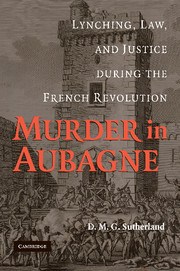Book contents
- Frontmatter
- Contents
- List of Figures
- Preface
- Acknowledgments
- Abbreviations
- Aubagne: An Introduction to the Problem
- 1 Structures and Events
- 2 The Olive Festival
- 3 Aubagne's Universe: Marseille, Aix, and Arles, 1789–1792
- 4 Murders in Provence
- 5 Vigilantism and Federalism
- 6 Federalism
- 7 Terror in a Small Town: Aubagne
- 8 The Revolution of the Antiterrorists: Vengeance, Massacre, and Justice
- 9 The Bande d'Aubagne
- Conclusion
- Appendix
- Sources and Methods
- Index
8 - The Revolution of the Antiterrorists: Vengeance, Massacre, and Justice
Published online by Cambridge University Press: 13 August 2009
- Frontmatter
- Contents
- List of Figures
- Preface
- Acknowledgments
- Abbreviations
- Aubagne: An Introduction to the Problem
- 1 Structures and Events
- 2 The Olive Festival
- 3 Aubagne's Universe: Marseille, Aix, and Arles, 1789–1792
- 4 Murders in Provence
- 5 Vigilantism and Federalism
- 6 Federalism
- 7 Terror in a Small Town: Aubagne
- 8 The Revolution of the Antiterrorists: Vengeance, Massacre, and Justice
- 9 The Bande d'Aubagne
- Conclusion
- Appendix
- Sources and Methods
- Index
Summary
Many unjust arrests dictated by resentment prove that men are not moderate in either party. The malevolent had done a lot of harm by atrocities; the good do it for revenge. The human race rarely knows how to maintain un juste milieu.
– Procureur syndic of the department of Bouches-du-Rhône to same of district of Salon, 13 Prairial year III – I June 1795The aftermath of the fall of Robespierre on 9 Thermidor, Year II, is usually treated as a depressing slide into vindictive violence and sickening corruption. One of the signs of this was the emergence of murder gangs throughout the Southeast. The gangs themselves are supposed to have been composed of draft dodgers, returned émigrés, former suspects, and relatives of victims of the guillotine. They were called either Companies of Jesus or Companies of the Sun. When their goal was not ignominious revenge for the Terror, they are usually labelled “royalist.” They thrived because of the complicity of sympathetic authorities who succeeded the local terrorists. New teams of representatives on mission purged the terrorists, and the new men were often victims of the Jacobins or their sworn enemies. Whatever the politics of these replacements, they were rarely very loyal to the Republic and many of them were secret royalists. The victims of the murder gangs were usually former terrorists, who could be murdered in any number of gruesome ways. The most spectacular was the prison massacre.
- Type
- Chapter
- Information
- Murder in AubagneLynching, Law, and Justice during the French Revolution, pp. 214 - 261Publisher: Cambridge University PressPrint publication year: 2009

